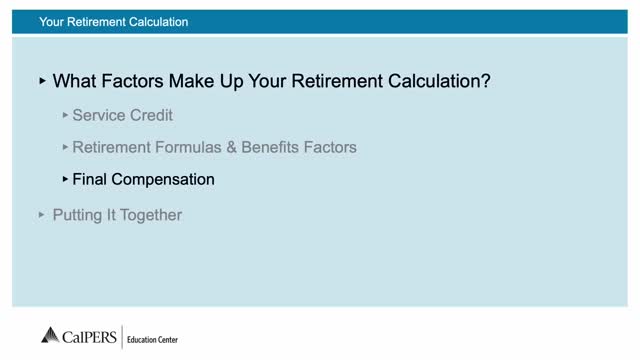CalPERS outlines final compensation calculation for retirement benefits
March 20, 2025 | California Public Employees Retirement System, Agencies under Office of the Governor, Executive, California
This article was created by AI summarizing key points discussed. AI makes mistakes, so for full details and context, please refer to the video of the full meeting. Please report any errors so we can fix them. Report an error »

The California Public Employees Retirement System (CalPERS) held a meeting on March 20, 2025, to discuss the intricacies of retirement calculations, focusing on the concept of Final Compensation. The session aimed to clarify how compensation is defined and how it impacts retirement benefits for employees.
The meeting began with a detailed explanation of what constitutes Compensation. It was defined as payments made to employees for services rendered during regular work hours, as well as for time off taken through vacation, sick leave, or other leave types. The discussion emphasized that employers may report additional forms of compensation, which could include payments for special skills or assignments.
Next, the meeting addressed Final Compensation, which is crucial for determining retirement benefits. Final Compensation is calculated based on the highest average full-time monthly pay rate over either 12 or 36 consecutive months, depending on the employee's contract and membership status with CalPERS. It was noted that this calculation does not consider part-time earnings but rather uses the full-time equivalent pay rate.
The meeting also highlighted specific scenarios affecting Final Compensation calculations, such as the impact of the Public Employees' Pension Reform Act (PEPRA) and the adjustments for school employees who work fewer months per year. An example was provided to illustrate how Final Compensation is computed, demonstrating the averaging process over a specified period.
Additionally, the meeting covered the Bridal Compensation Adjustment, which applies to employees who contribute to Social Security. This adjustment, a one-time calculation, affects the final compensation amount used to determine pension benefits. The adjustment is automatically included in retirement estimates for those affected.
The session concluded with a summary of the key factors influencing retirement calculations: years of service credit, the benefit factor based on age at retirement, and Final Compensation. Attendees were encouraged to utilize the Retirement Estimate Calculator available in their myCalPERS accounts to explore various retirement scenarios, such as the effects of delaying retirement or changing positions.
Overall, the meeting provided essential insights into the retirement calculation process, equipping employees with the knowledge needed to understand their potential benefits and make informed decisions regarding their retirement planning.
The meeting began with a detailed explanation of what constitutes Compensation. It was defined as payments made to employees for services rendered during regular work hours, as well as for time off taken through vacation, sick leave, or other leave types. The discussion emphasized that employers may report additional forms of compensation, which could include payments for special skills or assignments.
Next, the meeting addressed Final Compensation, which is crucial for determining retirement benefits. Final Compensation is calculated based on the highest average full-time monthly pay rate over either 12 or 36 consecutive months, depending on the employee's contract and membership status with CalPERS. It was noted that this calculation does not consider part-time earnings but rather uses the full-time equivalent pay rate.
The meeting also highlighted specific scenarios affecting Final Compensation calculations, such as the impact of the Public Employees' Pension Reform Act (PEPRA) and the adjustments for school employees who work fewer months per year. An example was provided to illustrate how Final Compensation is computed, demonstrating the averaging process over a specified period.
Additionally, the meeting covered the Bridal Compensation Adjustment, which applies to employees who contribute to Social Security. This adjustment, a one-time calculation, affects the final compensation amount used to determine pension benefits. The adjustment is automatically included in retirement estimates for those affected.
The session concluded with a summary of the key factors influencing retirement calculations: years of service credit, the benefit factor based on age at retirement, and Final Compensation. Attendees were encouraged to utilize the Retirement Estimate Calculator available in their myCalPERS accounts to explore various retirement scenarios, such as the effects of delaying retirement or changing positions.
Overall, the meeting provided essential insights into the retirement calculation process, equipping employees with the knowledge needed to understand their potential benefits and make informed decisions regarding their retirement planning.
View full meeting
This article is based on a recent meeting—watch the full video and explore the complete transcript for deeper insights into the discussion.
View full meeting
